Making pickled cabbage at home is easier than you think! With just a handful of simple ingredients and a few minutes of prep, you’ll have a tangy, zesty condiment ready to enjoy after a quick chill in the fridge (about 12-24 hours).
The secret to vibrant, flavorful pickled cabbage comes from a trick I learned from my Ukrainian mom—it adds the perfect pop of pink and a touch of sweetness.
I’ll walk you through each step so you can master this easy recipe with confidence.
Use pickled cabbage to brighten up hamburgers, hot dogs, chicken tacos, or even swap it in for slaw in shrimp tacos.

This blog is all about making delicious, homemade meals with fresh ingredients.
If you’re new here, check out my About page to learn how I can help you feel confident in the kitchen.
Ingredients for Pickled Cabbage
- Cabbage - I love using green cabbage because it’s tender and pairs beautifully with beets. Red cabbage works too, though it’s a bit firmer. Choose a dense head, not loose, for the best crunch and flavor.
- Beets - Beets add natural sweetness and a juicy bite when pickled. Red beets are my favorite for their sweetness and vibrant color. Want to switch it up? Try carrots or skip the beets entirely for classic cabbage pickles.
- Garlic - Thick slices of garlic infuse the brine with bold, savory flavor. They mellow out as they pickle, adding depth to the mix.
- Spices & seasonings - I love using whole spices like peppercorns, bay leaves, and mustard seeds for extra flavor. Avoid ground spices, as they can cloud the brine. Customize the seasonings to match your taste!
- Sugar - It balances the vinegar’s tang. Use regular sugar, honey, or agave for a milder sweetness.
- Salt - Fine or pickling salt works best to season and tenderize the cabbage while keeping it crisp. Red cabbage may need a bit more salt due to its firmness.
- Pickling liquid - Use vinegar with 5-6% acidity for the best pickles. White vinegar is classic, but apple cider, rice wine, or red wine vinegar add unique flavors too.
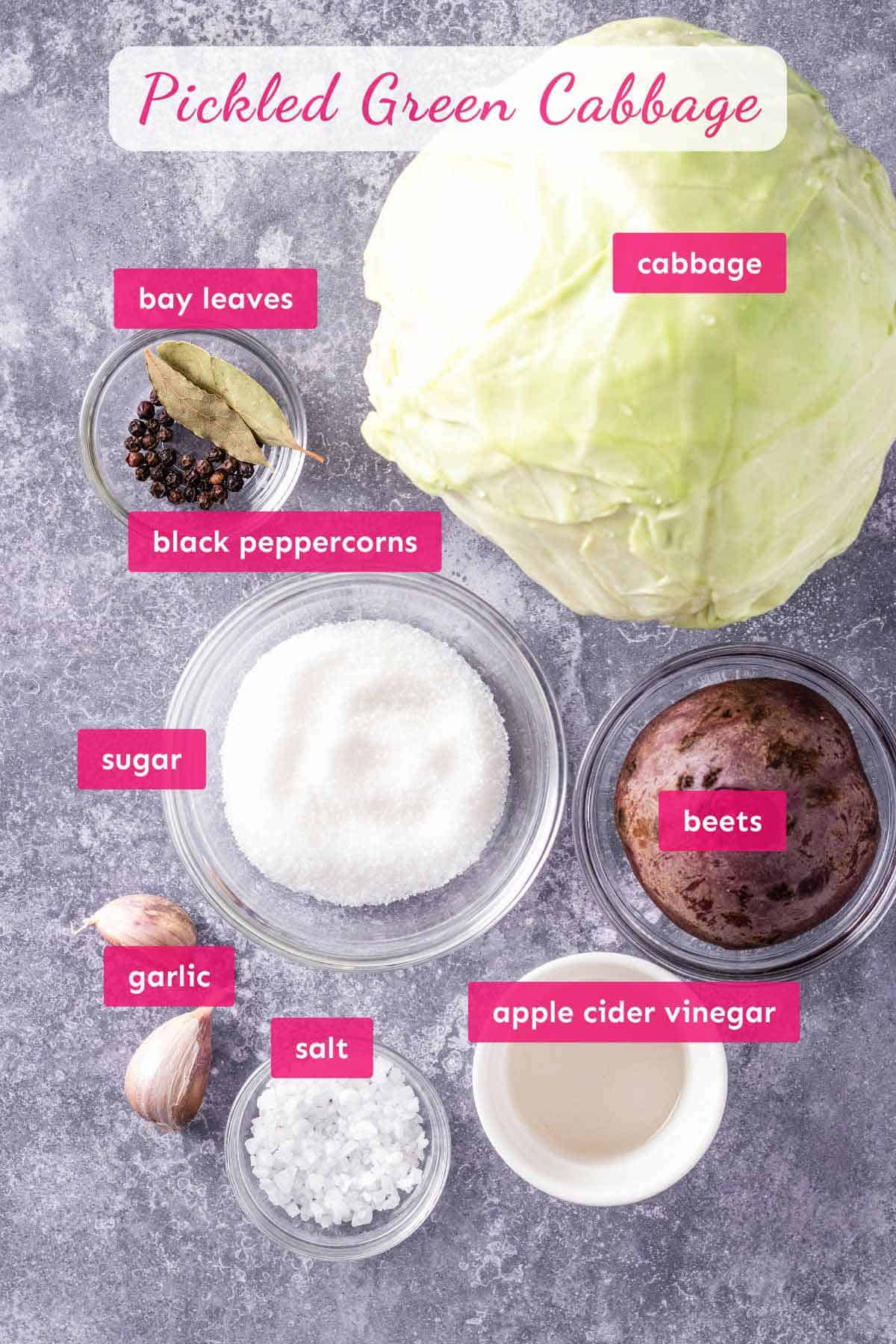
📋 You can find the full ingredient list in the Recipe Card below the article.
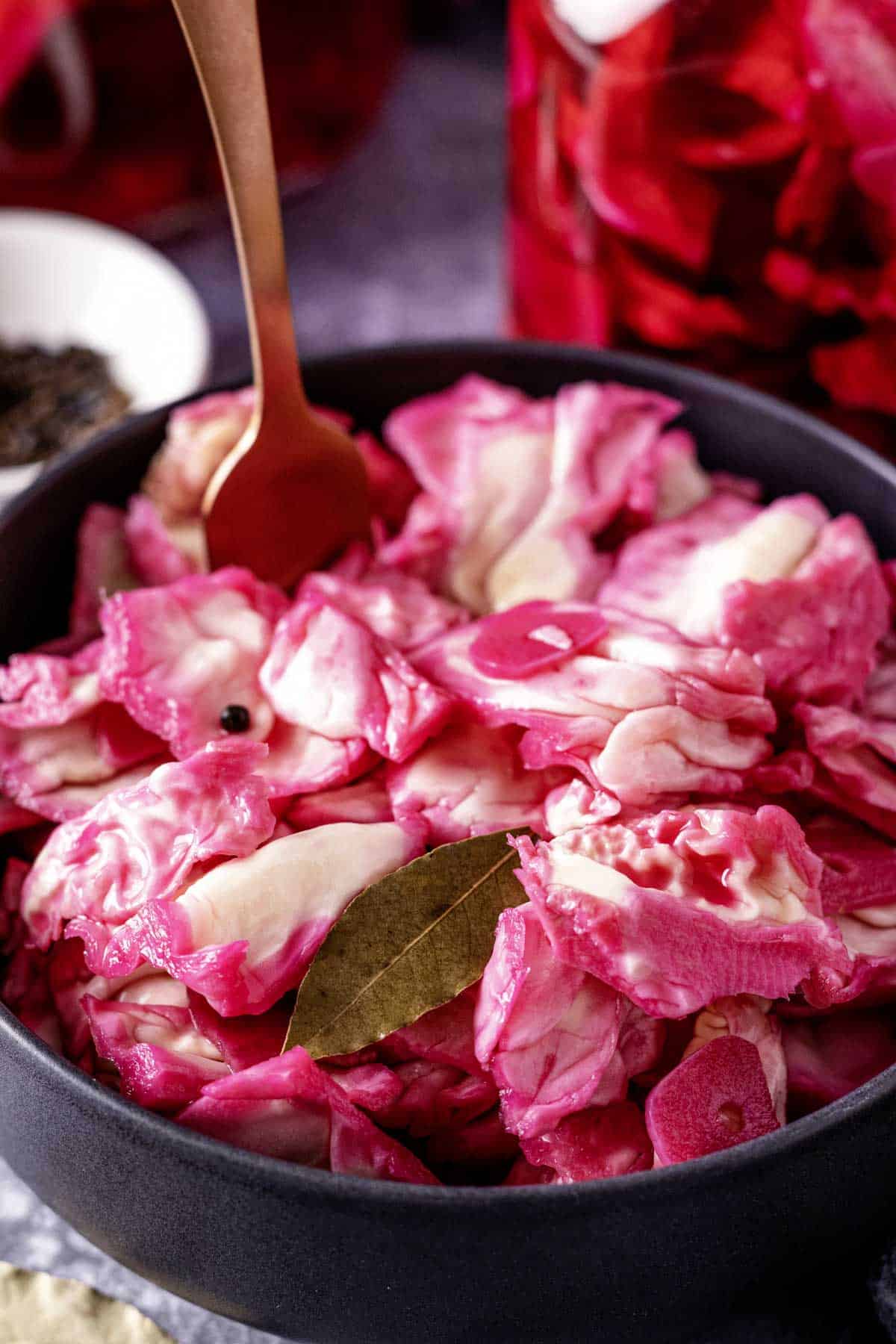
As this is an old family recipe, I wanted to keep it the same and cut the cabbage into thicker slices rather than shredding it.
This is how I’ve grown up enjoying it, but you can go for a sauerkraut style by slicing the cabbage thinly (mandoline does the trick perfectly) or opt for store-bought cabbage or coleslaw mix.
Want to Save This Recipe?
Enter your email and we’ll send the recipe directly to you!
By submitting this form, you consent to receive emails from The Yummy Bowl.
How To Make Pickled Cabbage
This easy pickled cabbage skips fermentation and is ready in 24 hours, though it tastes even better after 2 days in the fridge!
- Prep the cabbage and beets: Remove the cabbage’s outer leaves and cut out the core. Slice the cabbage into 1 ½-inch chunks or shred it like slaw if you prefer. Slice the beets thinly after cutting them in half.
- Layer the ingredients: In sterilized jars, layer cabbage, beets, and garlic slices. Repeat until the jars are full, leaving some space at the top.
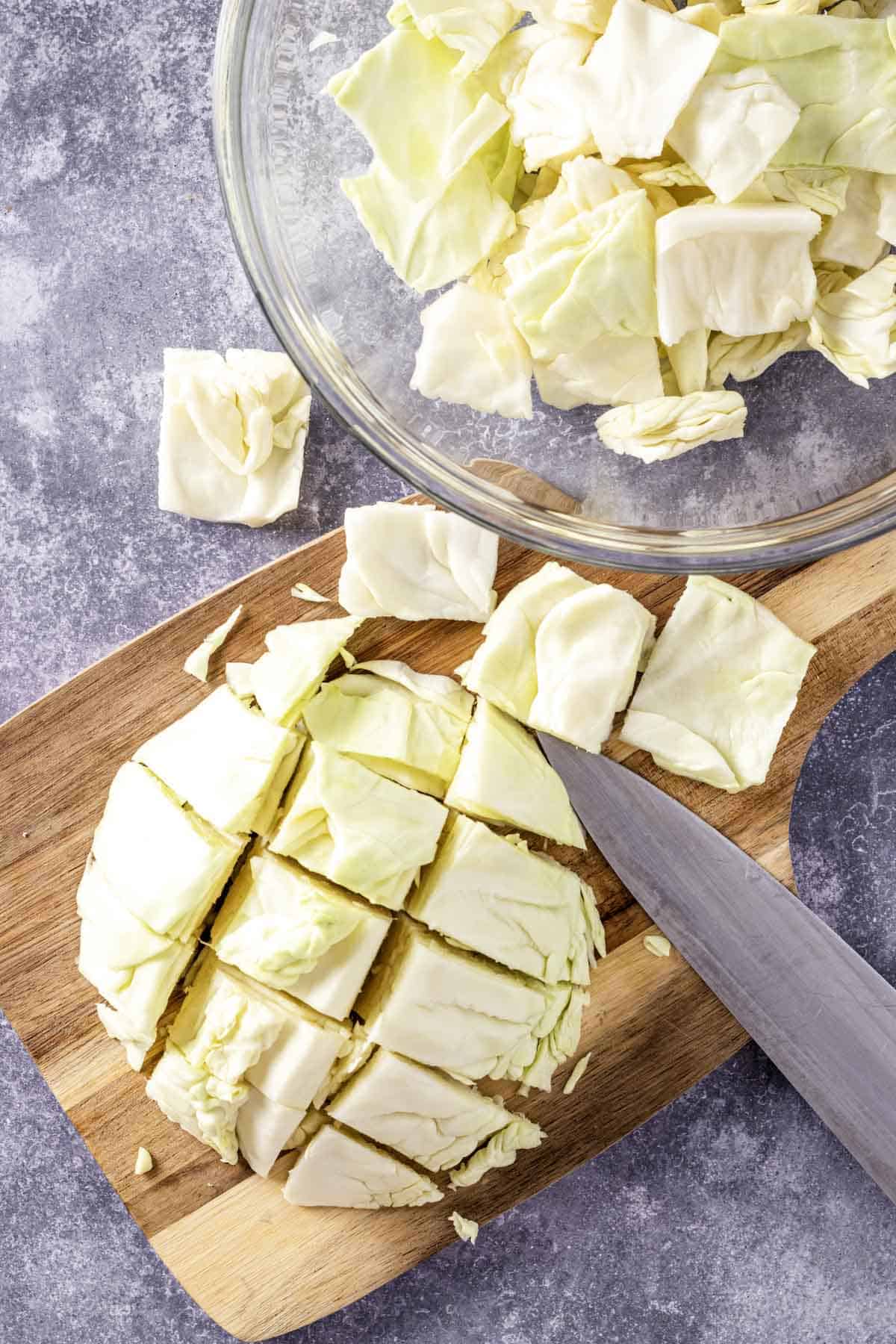
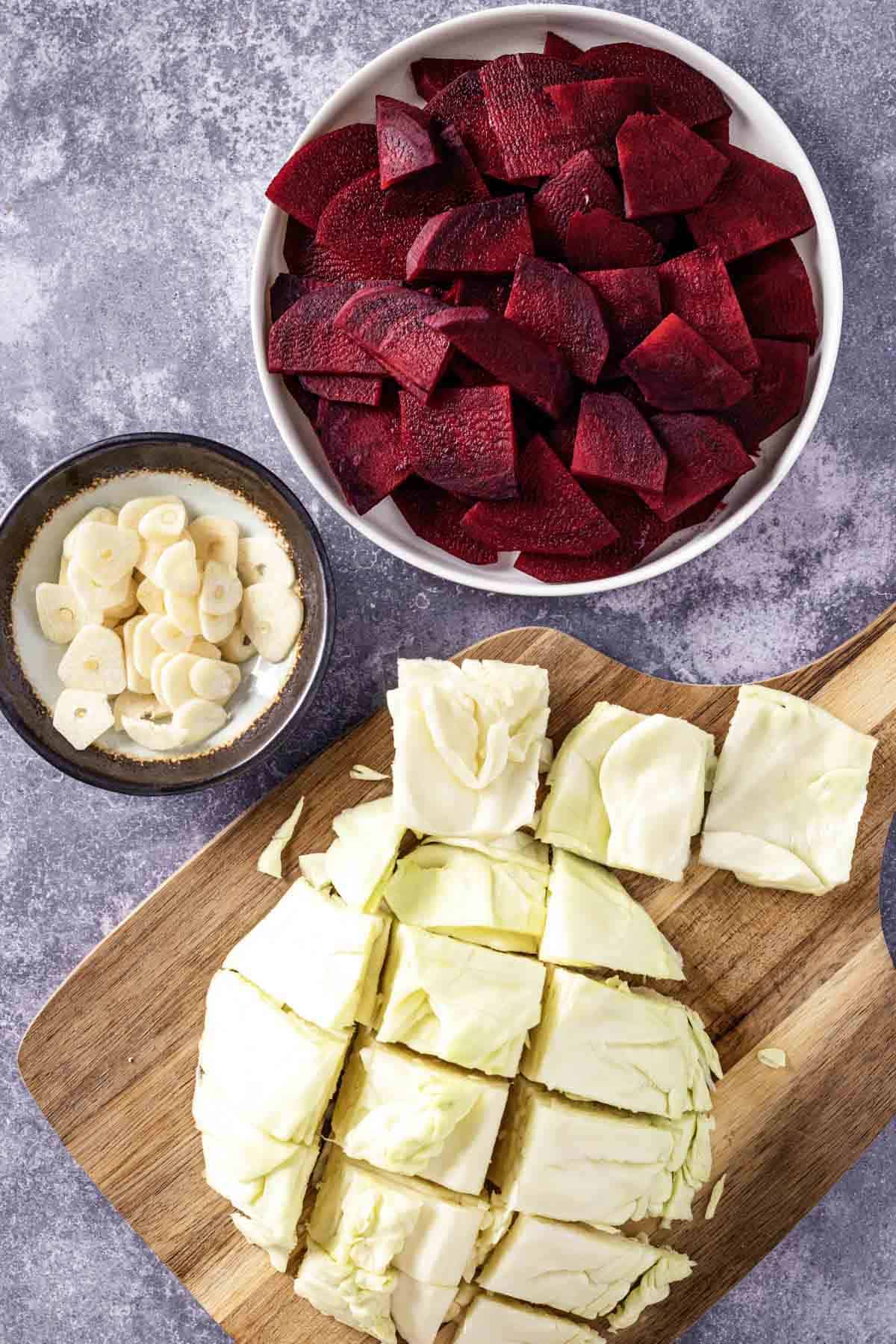
- Make the brine: In a saucepan, combine sugar, salt, peppercorns, and bay leaves. Add 6 cups of water and bring to a boil. Simmer for 3 minutes until the sugar and salt dissolve.
- Add vinegar: Remove from heat and stir in the vinegar. Let the brine cool for 1 minute. Carefully pour the hot brine over the cabbage mixture, ensuring the veggies are fully submerged with about 1 inch of space at the top.
- Seal and refrigerate: Seal the jars tightly and let them cool at room temperature for about 5 hours. Transfer to the refrigerator and marinate for at least 24 hours—2 days for maximum flavor.
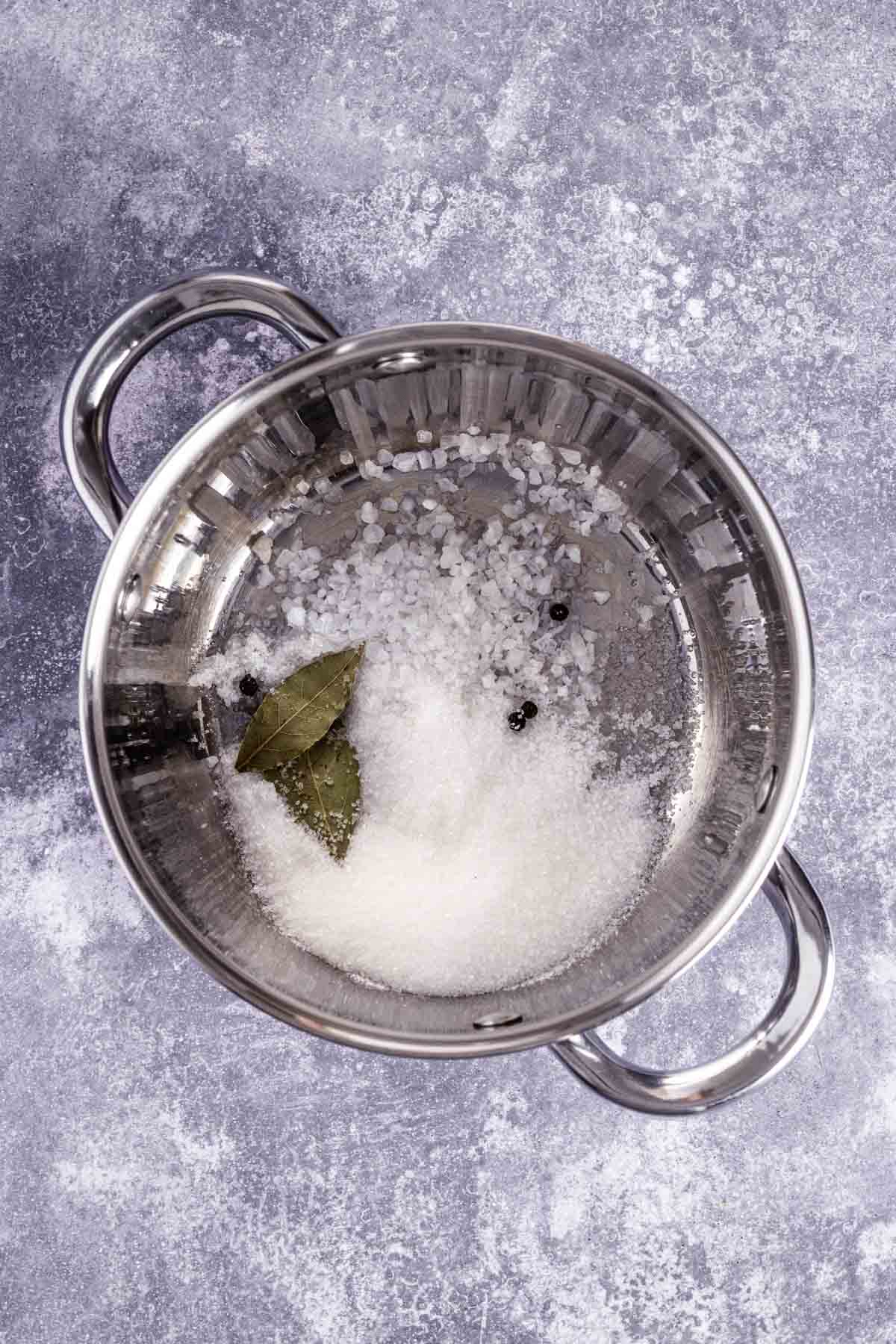

This recipe fills one 32-ounce and one 64-ounce jar, making about 3 liters of brine.
📋 TASTE & TEXTURE: Once pickled, cabbage takes on a slightly softened texture while maintaining a delightful tangy crunch. The zesty brine, complemented by a hint of sweetness from the beets, is simply delicious.
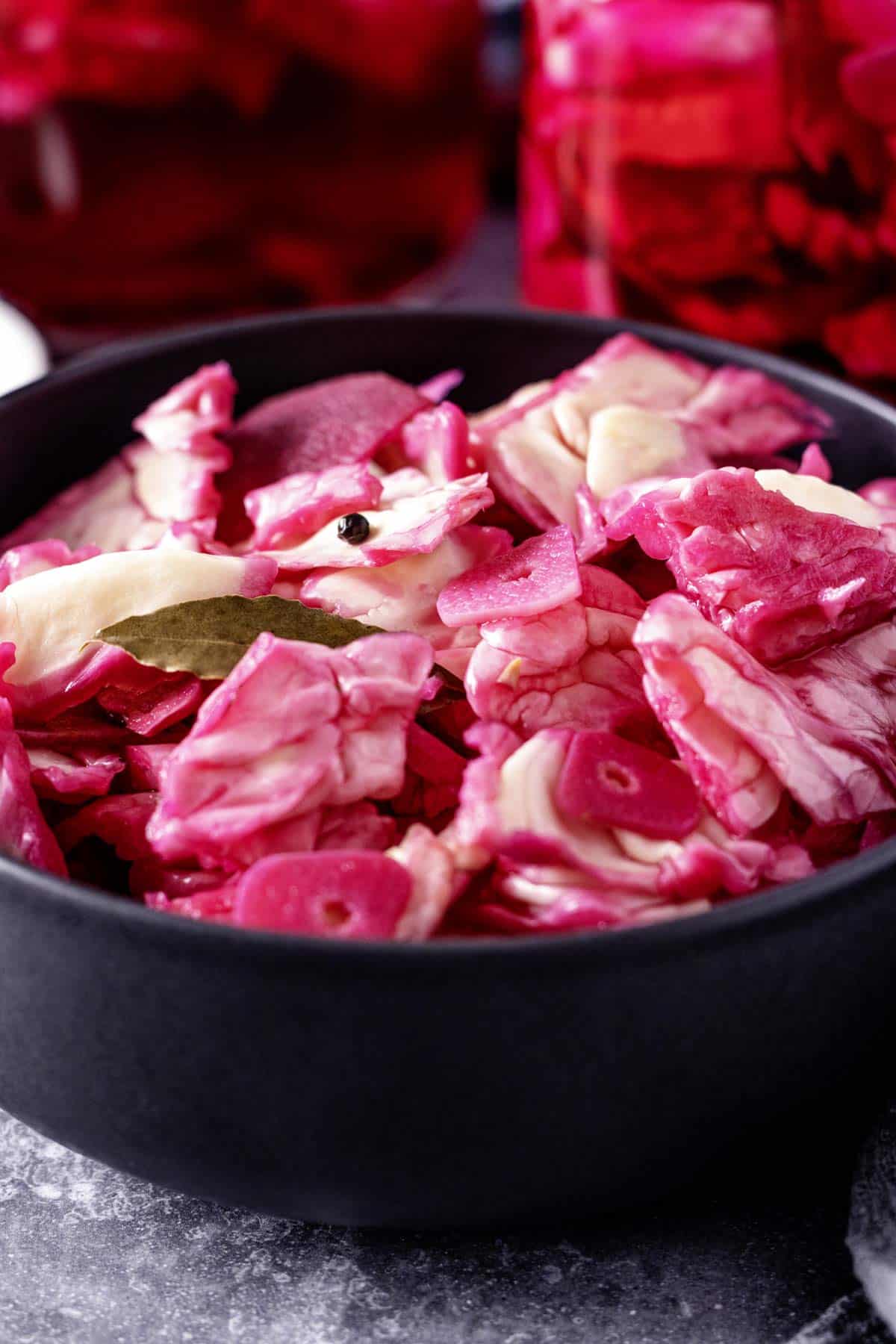
How To Sterilize Jars For Pickling
- Wash the mason jars and lids with hot, soapy water.
- Rinse off all the soap. Put the clean jars in a large pot of boiling water, making sure they are fully covered.
- Let them boil for about 10 minutes to sterilize.In another pot, boil the lids and bands for about 5 minutes.
- Carefully take the jars, lids, and bands out of the boiling water using jar tongs or a clean towel.
- Set them on a clean, dry surface and let them air dry completely before using them for pickling.
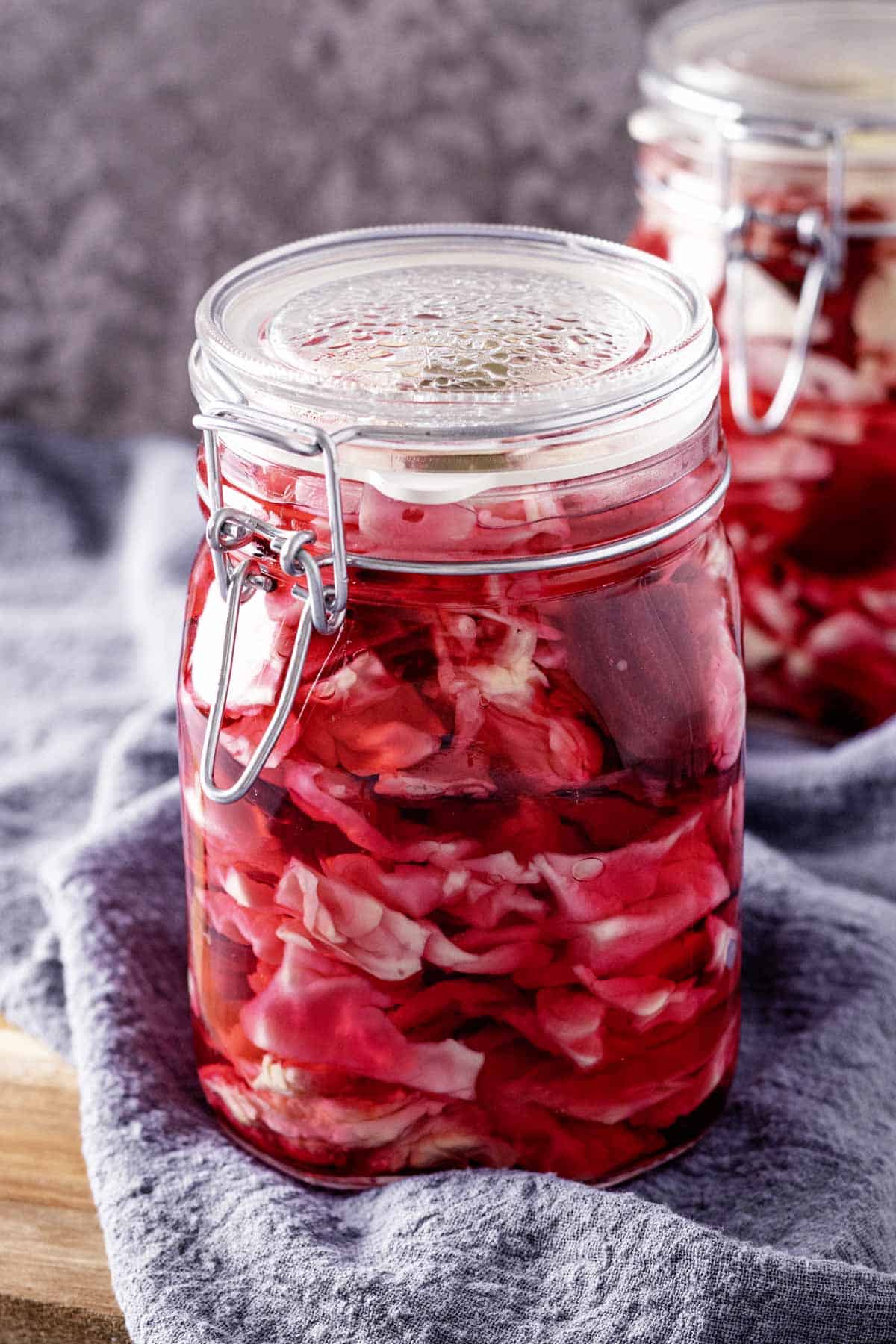
Tips
- If you prefer a sweeter pickled purple cabbage, add a bit more sugar to the boiling liquid. But I didn’t find it necessary in this recipe to add more!
- For your crunchy cabbage to last longer: allow the jars to cool to room temperature before refrigerating. Avoid putting them in the fridge while they are still hot.
- While you can eat the cabbage after 12-24 hours, letting it sit longer in the fridge will intensify its delicious taste (2-3 days is even better).
- Pickling brine without sugar - Sugar is often added to pickling brine to add sweetness and balance out the acidity of the vinegar. However, if you prefer a brine without sugar or are looking to reduce your sugar intake, you can omit it from the recipe. But be ready for some sour, pungent kick!
Is Pickled Cabbage Healthy?
While raw cabbage itself is highly nutritious, quick pickled cabbage typically uses vinegar, sugar and salt as the pickling agents, which means it may have a higher sodium content due to the salt.
However, you can control the amount of salt used in the pickling process to make it more suitable for your dietary needs.
While it may not provide the same gut health and probiotic benefits as fermented sauerkraut, refrigerator pickles still retain many of the nutrients present in raw cabbage.
Additionally, just like with any pickles, for better digestion, it is best to stick to small quantities as a condiment or side dish, rather than a large serving.
What To Do With Pickled Cabbage
The pickled cabbage not only has a tangy flavor but also adds a beautiful bright red color to your plate. It's a delicious condiment or side dish that goes with almost any dish.
How and what to eat with cabbage:
- As a topping - for hot dogs, burgers (try the cabbage instead of carrots in this chickpea burger), sandwiches, and lettuce wraps. You may need to slice it thinly if you want to add it as a topping.
- Nutritious topping - for veggie Buddha bowls/grain bowls, Korean pancakes, udon or soba noodles, ramen.
- As a filling - for spring rolls and salads!
- As a side dish - for main courses such as pork chops or tenderloin + mashed potatoes (my favorite combo), rump steak, mushroom chicken thighs.
- For sharing - add it to the Charcuterie Board and epic taco board.
- For breakfast - with scrambled eggs, poached eggs or frittata.
- Pickled Cabbage for tacos - it's great ‘’slaw’’ for tacos! Our favorite tacos to serve pickled cabbage with: cauliflower chickpea tacos, steak tacos, carnitas, and blackened fish tacos.
Freezing And Storing Instructions
For safe storage, always use glass jars rather than plastic containers or bowls without lids.
Glass jars with tight-fitting lids will help preserve the quality of the pickled cabbage.
- To Store. Allow the jars of pickled cabbage to cool down to room temperature before placing them in the refrigerator. As we are using raw ingredients, especially garlic which can reduce the pickle's shelf life to 2-3 weeks. I stored the cabbage for 3 weeks and in the end, it still had a nice crunch to it!
- Store the pickled cabbage in the middle of the fridge to avoid freezing in the back or shortening its lifespan in the doors. Keeping it in the optimal spot will help maintain its freshness for a longer period.
Variations
- More veggies - you can add different vegetables to the cabbage, such as large grated carrots or thin sticks, thinly sliced bell peppers, sliced onions, shallots, or small cauliflower florets.
- Pickled cabbage slaw Mexican style - try Curtido!
- Korean pickled cabbage - try traditional napa cabbage Kimchi!
- Japanese - try sweet and sour flavors of red cabbage.
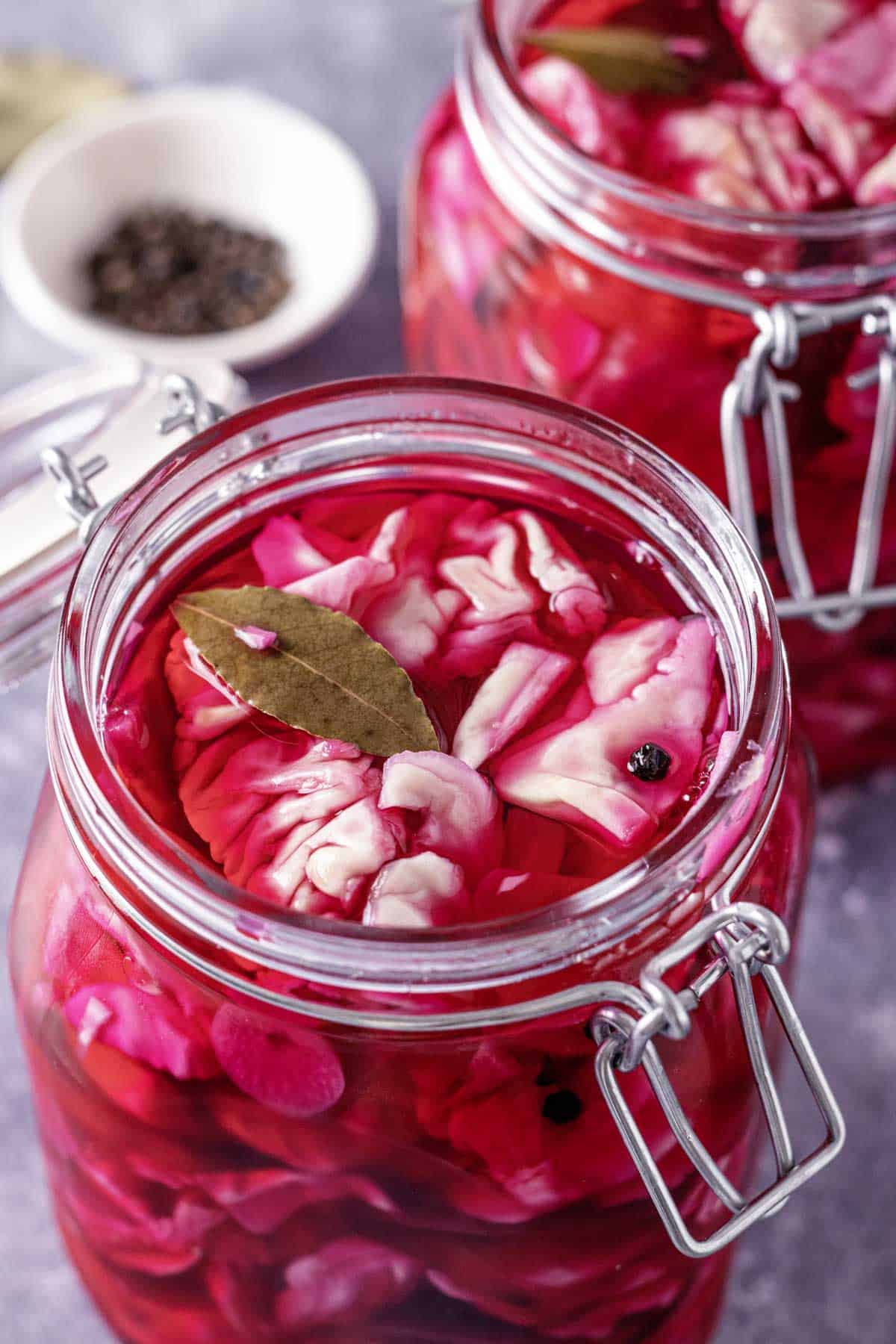
Customize The Brine
Ingredients like cabbage, beets and vinegar + water can’t be changed but when it comes to spices and seasonings you have loads of options:
- Use any vinegar you prefer, like apple cider vinegar for a tangy and fruity taste, or white, rice, or red wine vinegar for a softer flavor.
- Add extra flavor with ingredients such as curry leaves, caraway seeds, mustard seeds, celery seeds, turmeric, coriander seeds, or lime/lemon juice. Or use a homemade or store-bought pickling spice.
- To kick up the heat, incorporate chile peppers, jalapeno, red chili pepper, red pepper flakes, or sliced ginger for some spiciness.
- For a herbal twist, throw in a few sprigs of oregano, dill, thyme, chives, or rosemary.
More Pickled Veggie Recipes
Love Pickles? Try my pickled daikon radish and pickled asparagus where I’ve used the same quick pickling method and these are ready to enjoy after 24 hours!
We also love this corn relish and pickled red onion and radish recipes.
More Delicious Cabbage Recipes
Did You Like This Recipe?
Leave a ⭐️⭐️⭐️⭐️⭐️ rating below and share it on Instagram, Facebook, and Pinterest!
Recipe Card
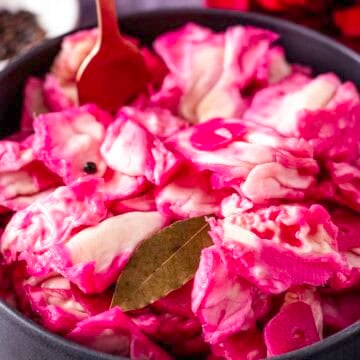
Pickled Cabbage Recipe
VIDEO
Want to Save This Recipe?
Enter your email and we’ll send the recipe directly to you!
By submitting this form, you consent to receive emails from The Yummy Bowl.
INGREDIENTS
For Cabbage
- 3 pounds green cabbage or red, (about 5-6 cups)
- 1 medium beet, about 6-7 ounce, peeled
- 8 small garlic cloves, about 1 ounce, cut into medium thick slices
For Pickling Brine
- 6 cups clean filtered water
- 3 tablespoon salt, fine sea salt or kosher salt
- ½ cup + 3 tablespoons apple cider vinegar, 5-6% acidity
- 10 black peppercorns
- 3 bay leaves
- 6 tablespoons sugar
INSTRUCTIONS
- Prepare the cabbage and beets. Remove the outer leaves and with a sharp knife cut out the core. Divide the cabbage into 4 wedges and chop each roughly into about 1 ½ inches slices.
- If you like, you can also slice it like you would for a simple cabbage slaw.
- For the beetroot, cut it in half and then into thin slices.
- In sterilized jars place a layer of cabbage, beet, and garlic. Repeat the layers until the jar is full.
- Make the vinegar marinade. In a saucepot place sugar, salt, peppercorns, bay leaves. Pour 6 cups of water on top and take it to a boil over medium heat. Simmer for 3 minutes until salt and sugar have dissolved in the liquid.
- Remove from heat and stir in the vinegar. Let cool slightly for 1 minute before pouring into the jars. Be careful when handling the hot pot with liquid!
- Pour the liquid until all the cabbage is fully submerged leaving an inch on top to close the lid easily and let the cabbage marinate.
- Refrigerate. Seal the lids tightly and let them fully cool at room temperature (it took me about 5 hours). After that refrigerate for 24 hours and enjoy! For more flavorful pickles, let marinate for 2 days.
- For this recipe, I used 1 32-ounce and 1 x 64 ounce jars (thsi recipe makes about 3 litre of brine in total).
NOTES
- This recipe makes about 8-10 servings.
- TASTE & TEXTURE Once pickled, cabbage takes on a slightly softened texture while maintaining a delightful tangy crunch. The zesty brine, complemented by a hint of sweetness from the beets, is simply delicious.
- For your crunchy cabbage to last longer: allow the jars to cool to room temperature before refrigerating. Avoid putting them in the fridge while they are still hot. While you can eat the cabbage after 12-24 hours, letting it sit longer in the fridge will intensify its delicious taste (2-3 days is even better).
- Cabbage - My go-to is green cabbage because it's tender and complements the color of the beets beautifully. However, red cabbage works well too. When selecting, opt for a large head of cabbage (you need to look for a denser and not very loose cabbage head which won’t yield crunchy results) to ensure the best flavor and texture.
- Beets - When pickled, beets bring a delightful, sweet, and juicy texture to the mix. For the best results, go for red beets as they tend to be sweeter. Alternatively, you can also experiment with carrots or other root vegetables if that's more to your liking. You can also make it just cabbage pickles, and leave the beet out entirely (I just love the sweet flavor and color it adds).
- Pickling liquid - The best vinegar to use for pickles is anything with 5-6% acidity. Distilled white vinegar or milder versions like apple cider vinegar, rice wine vinegar, or you can also use red wine vinegar. All are great for quick pickles.
ADD YOUR OWN PRIVATE NOTES
NUTRITION
Note: Nutrition information is estimated and varies based on the products used.
Full Nutrition Disclaimer can be found here.




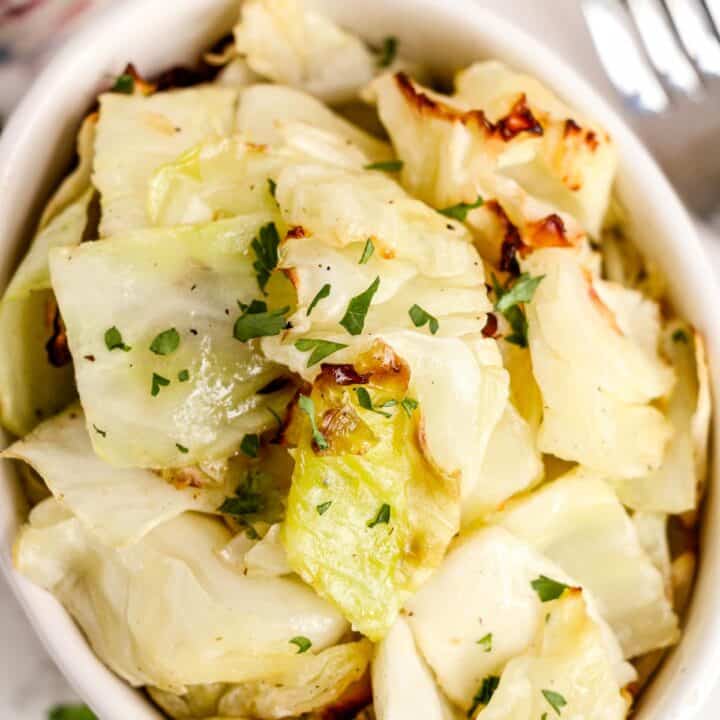
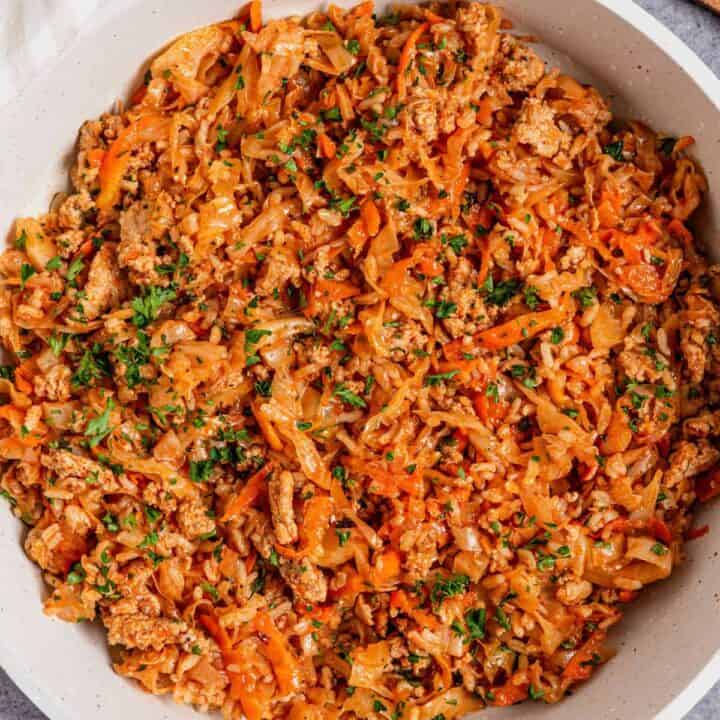
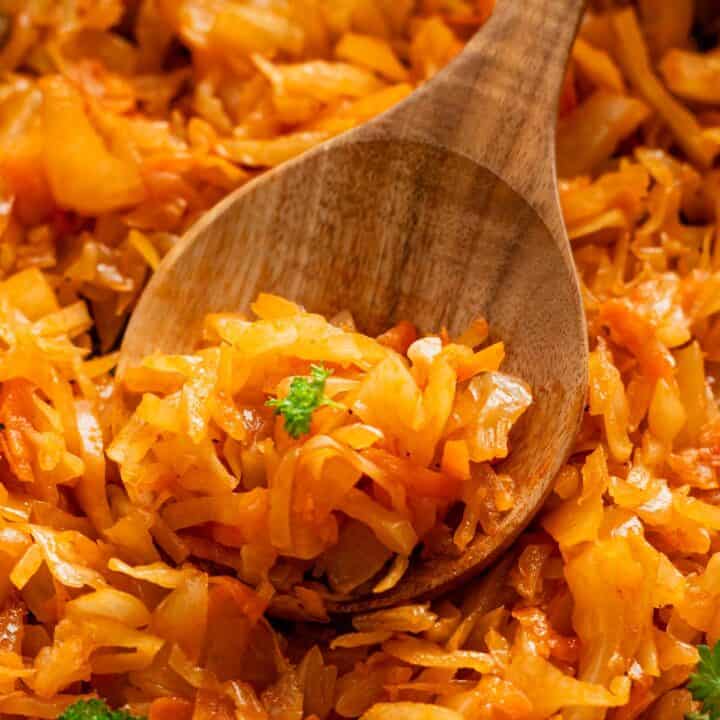
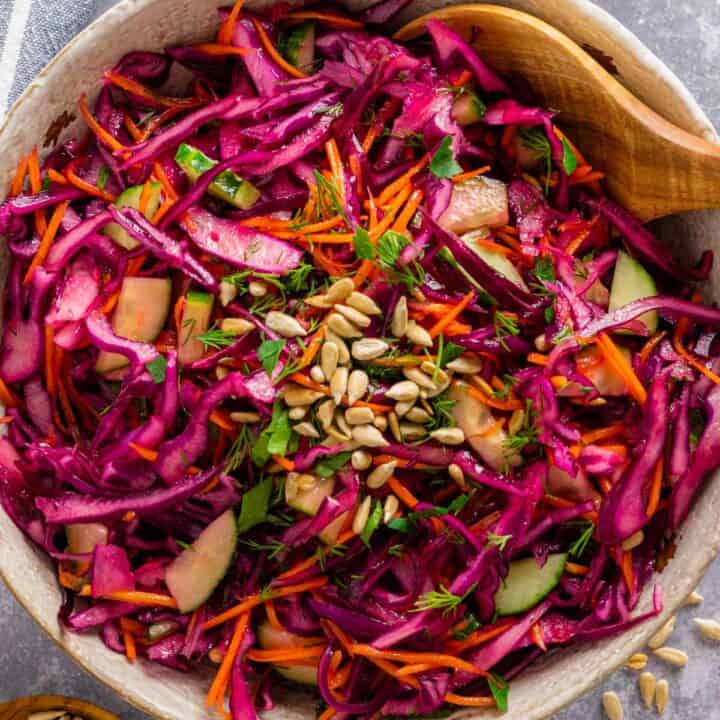
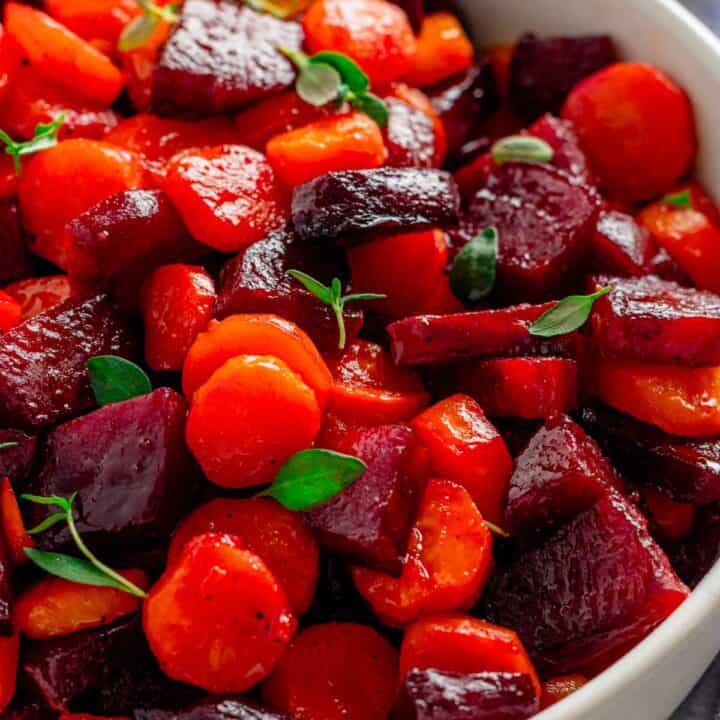

Nadeen
Posted recipe for brine, lists
6T sugar ( fine sea or kosher salt)
Which ingredient is correct??? Sugar or salt...or 6T of both??
Julia | The Yummy Bowl
sugar, corrected now thanks!
Julia | The Yummy Bowl
This pickled cabbage is an excellent quick and delicious side dish to enjoy any time of the year!